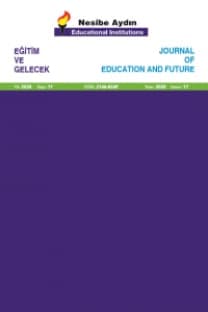Çevre Okuryazarlığı: Türkiye’deki Peyzaj Mimarlığı Öğrencileri ile İlgili Bir Değerlendirme
Environmental Literacy: An Assessment and Evaluation on the Students of Landscape Architecture in Turkey
___
- Ammar, N. (2003). İslamda Ekolojik adalet ve kadınlar için insan hakları. İslam ve bahşedilmiş bir emanet [Islam and Ecology: A best so we trust]. In Richard C. Foltz, Frederick M., Dennyand Azizan Baharuddin (Ed.), Islam and Ecology: A best so we trust. The president and fellows of Harward College-Oğlak Yayıncılık ve Reklamcılık Ltd. Şti. İstanbul.
- Berkowitz, A.R., M.E. Ford, &. Brewer, C.A. (2005). A framework for integrating ecological literacy, civics literacy, and environmental citizenship in environmental education. In Johnson, E.A., and M.J. Mappin (Ed.), Environmental Educationor Advocacy: Perspectives of Ecology and Education in Environmental Education. New York, NY: Cambridge University Press. pp. 227-265.
- Cheng, I.N.Y., & So, W.W.M. (2014). Teachers’ environmental literacy and teaching –stories of three Hong Kong primary school teachers. International Research in Geographical and Environmental Education, 24 (1), 58-79, http://dx.doi.org/10.1080/10382046.2014.967111
- Demiroğlu D., Görmüş S. Birişçi T., Erdoğan R., Kalaycı Önaç A., Karadağ A. A. & Sezen I. (2014). Öğrenci Odaklı Peyzaj Mimarlığı Eğitim-Öğretiminde Stajın Yeri ve Önemi (Importance of Job Training in Student-Oriented Landscape Architecture Education]. In V. Ortaçeşme (Ed). I. Peyzaj Mimarlığı Eğitim Öğretim Çalıştayı Bildiriler Kitabı, pp. 251-265.
- Gayford, C.G., & Dillon, P.J. (1995). Policy and the practice of environmental education in England: A dilemma for teachers. Environmental Education Research, 1 (2), 173-184.
- Gazdova, D. (2002). Characteristics of modern landscape architecture and its education. Landscape and Urban Planning 60 (2002), 117–133.
- Güzer, B.D. (2000). Bir Süreklilik Sorunu Olarak Eğitim, Tasarım ve Planlama Süreçleri [Education, Design and Planning Processes as a Sustainability Problem]. Peyzaj Mimarlığı Kongresi, 187-190, Ankara.
- Harvey, D. (1997). Postmodernliğin Durumu [The Condition of Postmodernism]. (Turkish: S. Savran), Metis Publishing, İstanbul.
- Intergovernmental Panel on Climate Change (2007). Climate Change 2007: The Physical Science Basis. Summary for Policy Makers. A Report of Working Group I of the Intergovernmental Panel on Climate Change. Geneva, Switzerland: IPCC.
- IUCN, (2002). Education and Sustainability Responding to the Global Challenge. In D. Tilbury, R.B. Stevenson, J. Fien, D. Schreuder (Ed). IUCN Commission on Education and Communication (CEC) and IUCN–The World Conservation Union 2002. http://ibcperu.org/doc/isis/13028.pdf
- Lefebvre, H. (2009). Mekânın Üretimi [Production of Space]. I. Ergüden (Tr). 2014, Sel Publishing, İstanbul.
- McBride, B. B. (2011). Essential Elements of Ecological Literacy and the Pathways to Achieve It: Perspectives of Ecologists. Ph. D. Dissertation Univ. Of Montana Missoula University of Montana Scholar Works, http://scholarworks.umt.edu/etd.
- Moody G., Alkaff H., Garrison D., & Golley F. (2005). Assessing the Environmental Literacy Requirement at the University of Georgia. The Journal of Environmental Education, 36 (4), 3-9.
- Orr, D.W. (1992). Ecological literacy: Education and the transition to a postmodern world. Albany: State University of New York.
- Palmer, M., E. Bernhardt, E. Chornesky, S. Collins, A. Dobson, C. Duke, B. Gold, R. Jacobson, S. Kingsland, R. Kranz, M. Mappin, M.L. Martinez, F. Micheli, J. Morse, M. Pace, M. Pascual, S.
- Palumbi, O.J. Reichman, A. Simons, A. Townsend, & Turner M. (2004). Ecology for a crowded planet. Science 304, 1251-1252.
- Pe’er, S., Goldman, D., & Yavetz, B. (2007). Environmental literacy in teacher training: Attitudes, knowledge, and environmental behavior of beginning students. The Journal of Environmental Education, 39(1), 45-59.
- Roth, C. E. (1968). Curriculum Overview for Developing Environmentally Literate Citizens. ERIC Reproduction Service No. ED 032982.
- Roth, C. E. (1992). Environmental Literacy: Its roots, evolution and directions in the 1990s. ERIC/CSMEE Publications, The Ohio State University, http://files.eric.ed.gov/fulltext/ED348235.pdf
- Simmons, D. (1995). Developing a framework for national environmental education standards. In papers on the Development of Environmental Education Standards (pp. 53-58). Troy, OH: NAAEE
- Teksöz Tuncer G. Şahin E. & Ertepınar H. (2010). Çevre Okuryazarlığı, Öğretmen Adayları ve Sürdürülebilir Gelecek [Environmental Literacy, Pre-Service Teachers, and A Sustainable Future]. Hacettepe Üniversitesi Eğitim Fakültesi Dergisi [Hacettepe University Journal of Faculty of Education], 39 (39), 307-320.
- Teksöz Tuncer G., Alp G. E. & Ertepınar H. (2008). Ankara’daki Eğitim Fakültelerinde Çevre Okuryazarlığının Belirlenmesi [Determination of Environmental Literacy in the Faculties of Education in Ankara]. TÜBİTAK Araştırma Projesi Sonuç Raporu, Ankara.
- The Tribilisi Declaration, (1977). The Tbilisi decleration: final report intergovernmental conference on environmental education. Organized by UNESCO in Corporation with UNEP, http://www.gdrc.org/uem/ee/EE-Tbilisi_1977.pdf)
- Thomas, I. & Nicita, J. (2002). Sustainability Education and Australian Universities. Environmental Education Research, 8 (4), 475-492.
- UNESCO-UNEP (United Nations Educational, Scientific and Cultural Organization-United Nations Environment Program). (1989). Environmental literacy for all. Connect, 14 (2), 1-8.
- ISSN: 2146-8249
- Yayın Aralığı: Yılda 2 Sayı
- Başlangıç: 2012
- Yayıncı: Nesibe Aydın Eğitim Kurumları
Okul Yönetiminde Beklentilerin Gücü: Pygmalion Etkisi
Mukadder BOYDAK ÖZAN, Seda GÜNDÜZALP
Çevre Okuryazarlığı: Türkiye’deki Peyzaj Mimarlığı Öğrencileri ile İlgili Bir Değerlendirme
Sayı Doğrusu Tahmin Becerisinin Geometrik Yönü
Glenn Gordon SMITH, Sinan OLKUN, Mehmet Hayri SARI
Mustafa ALTUN, Khabib AKHMADJONOV
Yaşam Boyu Öğrenme için Kişilerarası İletişim Eğilimleri: Birinci Sınıf Öğrencileri Örneği
Sosyal Destek Algısı ve Akıllı Telefon Bağımlılığı İlişkisinde Etkileşim Kaygısının Aracılık Rolü
Bibliyoterapi Yönteminin Üstün Zekâlı/Yetenekli Öğrencilerin Problem Çözme Becerisine Etkisi
Arttırılmış Gerçekliğin Eğitsel Potansiyeli: Öğretim Tasarımcılarının ve Uygulayıcıların Deneyimleri
Rabia M. YILMAZ, Yüksel GÖKTAŞ, Ömer KOÇAK, Sevda KÜÇÜK
Yazma Sınıfının Ters Yüz Edilmesi: Yazmayı Geliştirmek için Dilbilgisi Videolarının Kullanımı
